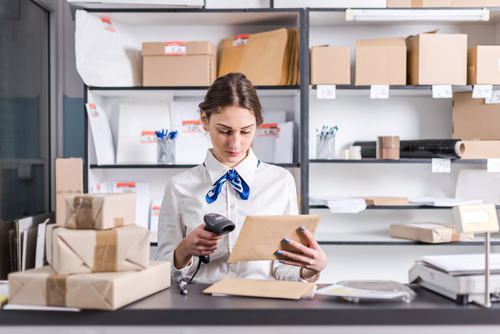
Source: rlat/ Shutterstock.com
Several factors to consider when deciding how to ship a package include size, weight and item type. For small, lightweight items, parcel shipping is the most common and economical way to transport your goods.
However, to make the most of parcel shipping benefits, you need the proper protective packaging to ensure your goods arrive safely at their destination.
What Is Parcel Shipping?
If you are a company that ships small items regularly, parcel shipping is an economical freight option. Goods shipped via parcel shipping are lightweight and with small, standard dimensions easy to deliver for a single driver. To be considered a parcel, it must be an individual shipment under 150 lbs.
No Matter What, You’ll Need Shipping Box Containers
Four facts about parcel shipping:
- Parcel shipping refers to small, lightweight items under 150 lbs. carried by truck or plane.
- Parcel shipping is cost-effective, fast and efficient for small businesses.
- Parcels are loaded loosely onto vehicles and require specialized packaging.
- Perishable goods need insulating and cooling packaging for successful delivery.
Parcel Shipping for Perishable Items
Parcel shipping is a quick and efficient transportation method, making it ideal for delivering perishable goods. Perishable foods are unsafe to eat unless they’re refrigerated at 40°F or below or frozen. Perishable items can be exposed to multiple temperatures or humidities during transit, so it’s essential to ship them in the proper packaging.
With the proper combination of insulation and refrigeration, you can prevent perishables from spoiling. Common insulation materials include expanded polystyrene foam or reflective foil box liners. Gel coolants and dry ice are both regularly used for refrigeration. However, if you’re transporting live seafood, such as crabs or lobsters, use gel coolants instead of dry ice to prevent contamination.

Source: Freedomz/ Shutterstock.com
How to Prepare Packages for Shipment
An analysis of international air parcel shipping showed that single parcels endure frequent velocity changes and sudden height drops, damaging items. Similarly, courier trucks often travel at high speed and need to stop suddenly, causing items to shift during transit.
Shipping Perishables? Check Out Our Guide!
Unlike LTL shipments secured on pallets for transport, parcel shipments are loosely placed in trucks or airplanes, so protective packaging is critical for safe transit.
Place your parcel in new or sturdy shipping box containers large enough for the package plus room for bubble wrap, styrofoam packing peanuts or other protective materials. Once the parcel is secured inside the box, you’ll need to use 2” wide packaging tape to seal the box. Be sure not to use Scotch tape or duct tape, as the adhesive can deteriorate and cause the goods to spill or get damaged.
When shipping perishables, it’s essential to keep heat and moisture out and cool temperatures in. Produce, meat, frozen foods, pharmaceuticals or fresh flowers are all perishable. Styrofoam packaging is ideal for seafood and ice cream, as it acts as both an insulator and a protective barrier.
Once your parcel is properly boxed and taped, you must weigh and measure it. You’ll need to measure the length, width and height of the package and address it as you would address an envelope. Write the sender’s address in the top left corner of the box and the recipient’s address centered beneath the sender’s address. For perishable parcel shipments, also include a 24-hour contact phone number for the recipient and the shipper.

Source: Simone Hogan/ Shutterstock.com
How Are They Transported?
Since parcels are small packages, they’re directly picked up from drop-off locations and are auto-sorted by machines. Once sorted, the parcels are loaded onto trucks and are typically delivered to the location or are transferred before arriving at the final destination.
Benefits of Parcel Shipping
- Ideal for small packages
- Faster domestic shipments
- Ships directly from drop-off locations
- Delivers directly to a residential or business address
- Lower freight costs
What’s the Difference Between Parcel and LTL Shipping?
Unlike parcels, LTL typically deals with larger packages. LTL shipments are usually stored on pallets, while parcels are loaded directly onto a truck. Here are some key differences between parcel and LTL shipping:
1. Damage and Loss Prevention
Parcel shipping has a higher chance that it will become lost or damaged than LTL
shipments. However, parcels are smaller and can be packed in higher volumes.
2. Tracking and Checkpoints
Parcel packages go through several checkpoints, so carriers are updated more
frequently than LTL packages, making the parcel easy to track. However, fewer checkpoints with LTL shipment increase the chances of a safe delivery.
3. Costs
LTL packages are larger, resulting in higher shipment costs. Many carriers have
additional charges tacked onto original pricing, such as extra fees for correcting an address mid-delivery.
Final Thoughts
For a small business that regularly ships lightweight goods, parcel shipping offers a cost-effective and speedy way to deliver items to your customers. But, to ensure your packages arrive safely, you need the right packaging materials.
At Air Sea Containers, we carry a wide range of protective packaging, including Styrofoam boxes, packing peanuts and air pillows. Browse our catalog online, or explore our blog to learn more about choosing the right packaging and shipping method to help your business.
[ad_2]
Source link


